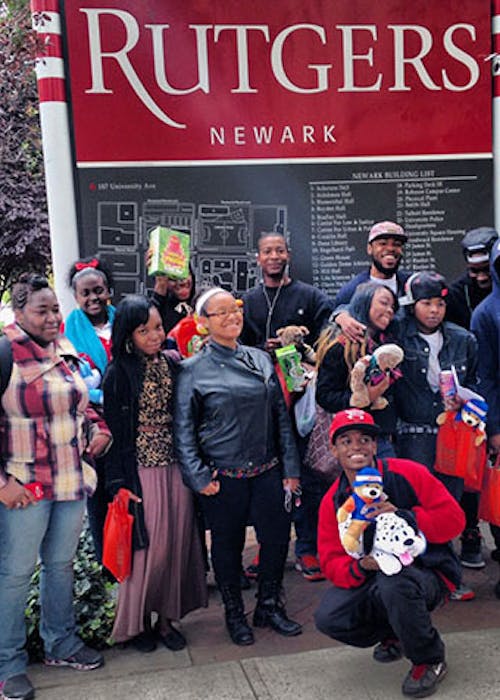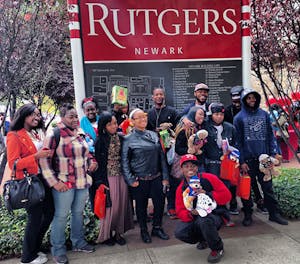
Brownsville programs help youth reimagine their trajectories
Insights
April 5, 2017

Brownsville Community Justice Center participants visiting Rutgers University as part of the college bound programming.
Back in the ‘90s, Brownsville native Kyle Hollins would play basketball with friends in Fresh Pond, Queens. After the games, he and his friends would sometimes linger, hanging out and catching up.
The more time he spent in Fresh Pond, the more he noticed disparities in resources between that community and his own. Galvanized by this realization, he founded the Brownsville Youth Association in 1997 hoping to engage children and teens and give them productive programming after school and in the summers.
Two decades later, the program now serves more than 300 Brownsville youth with an array of critical programs. Youth and young adults can take GED prep classes, career development workshops, and health workshops on topics like Smoking Cessation and Diabetes and Nutrition Awareness. They can play recreational sports, get homework help, computer training and creative arts programming, and can sign up to teach seniors technology skills. These programs and others held regularly throughout the year, like Father’s Day barbecues and violence prevention workshops, not only give youth productive activities to enjoy but equip them with crucial skills and training that help them reimagine their trajectories.
Initiatives like this are key for the community. Our new report, From Strengths to Solutions: An Asset-Based Approach to Meeting Community Needs in Brownsville, identifies fear of crime as the number one concern of Brownsville residents. It has a tangible impact on their daily lives, keeping them inside at night and sometimes almost all the time, and dictating where they go and what resources and programs they feel safe enough to access.
One possible reason for this cited by community members is that older youth simply do not have enough to do. Nearly one in three Brownsville residents is under 18, but there is not enough youth programming to serve them all. Without structure and a place to be after school and in the summer, they can get into the trouble that spikes crime and makes community members feel less safe.
Individuals and programs throughout the community are working to change that. In addition to the Brownsville Youth Association, the Brownsville Community Justice Center works with youth who have come into contact with the criminal justice system to help them find off-ramps from the system through a variety of initiatives.
One program, through the NYC Department of Probation, connects teens and young adults who have been in contact with the system in the last twelve months to GED classes, college assistance, internships and job training, and community benefit projects. Another, called Youth Court, trains youth to hear real cases involving their peers and decide on sanctions to meant to repair any damage and deter future irresponsible behavior. Other programs include workforce skills development, reading, writing and critical thinking workshops, anti-violence initiatives, and efforts to revitalize public spaces.
About half the youth who are referred to the Center end up securing paid internships through the Justice Center that not only keep them occupied and give them a sense of purpose, but also help them gain skills and earn money that can lay the groundwork for a future career.
“A lot of people in Brownsville experience generational poverty and feel like there’s no way out,” said James Brodick, Director of the Brownsville Community Justice Center. “Once we introduce our young people to opportunities, they start to feel hopeful about their futures.”
Teens and young adults involved with the Brownsville Youth Association also often find themselves there longer than they initially expect. Many of the youth who attended the Association’s programming as kids now work there as tutors, child care workers, and counselors.
“It’s all about giving them that career mindset and providing avenues for them to learn and get job training,” says Hollins.
When they get that training and the resources they need, there is no limit to what they can do. One young man who got involved with the Community Justice Center took advantage of coding classes to create his own video game. The point of the game? To explore Brownsville through a virtual depiction of the community and figure out how to address public safety barriers the player encounters.
“When we teach young people a skill, they put that skill into practice for the benefit of the community at large,” says James. “These investments in young people create a new generation of problem-solvers.”
To further expand this work, both Hollins and Brodick called for an increased investment in job training and economic development opportunities in the community.
“If we can get kids career or vocational training at a young age, they can be set up for life,” says Hollins.
Expanded job training paired with investment in local entrepreneurship could be a huge boon to Brownsville residents. “We’re working to spark an entrepreneurial spirit and help people who have great ideas make them into full blown businesses,” Brodick says.

